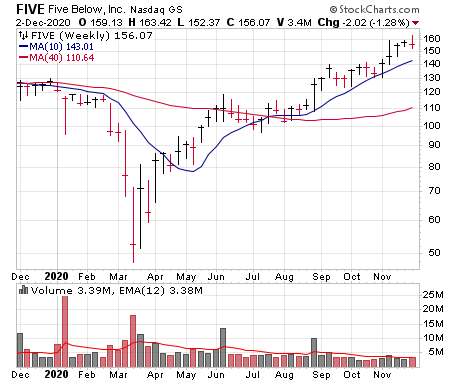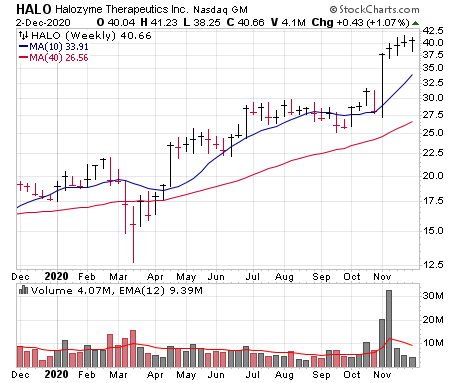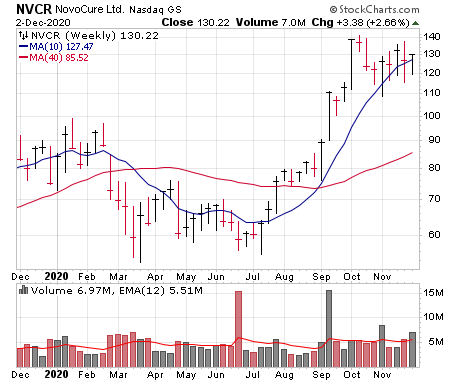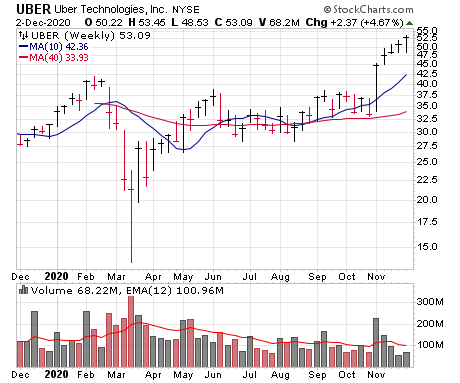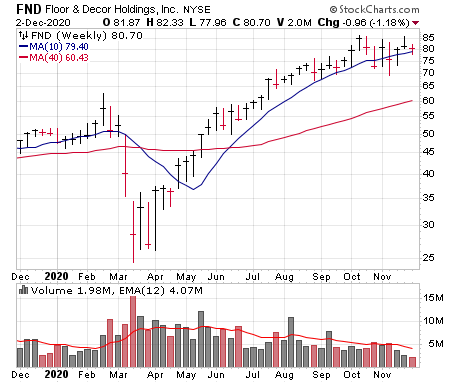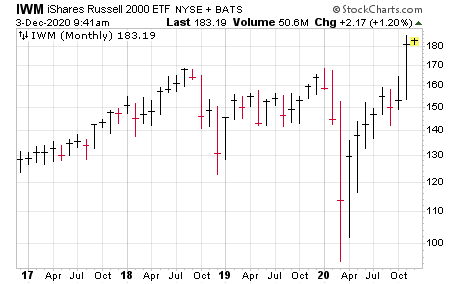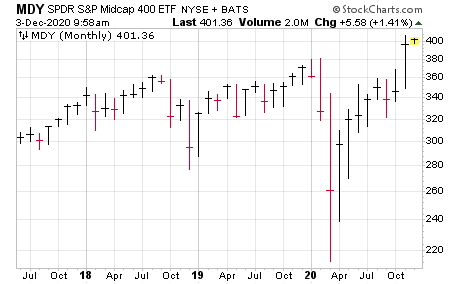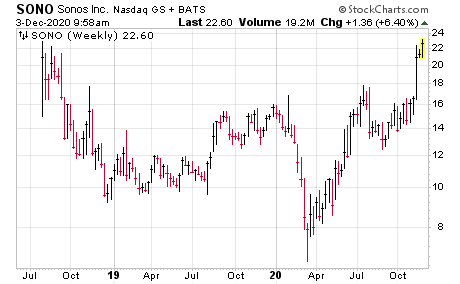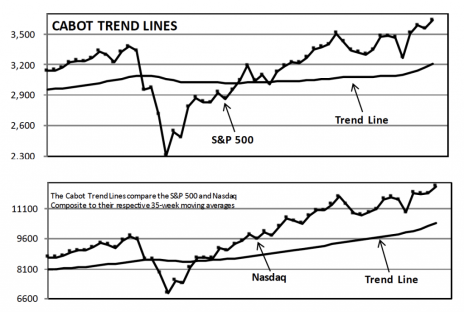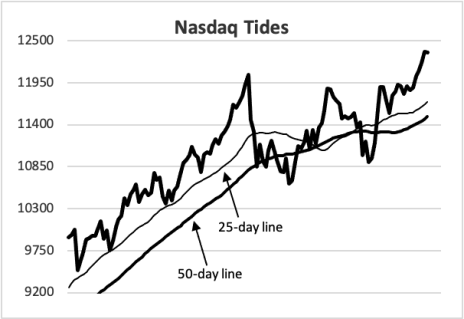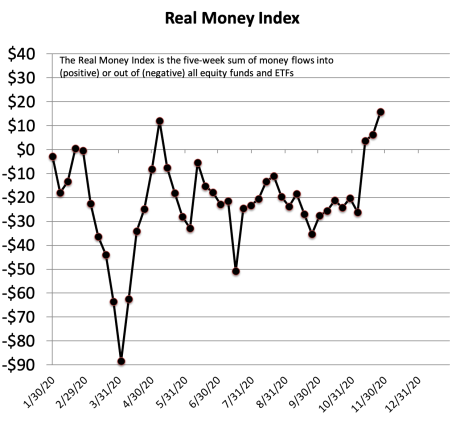The market remains in great shape, and even better, growth stocks have (mostly) avoided any further severe rotation in recent weeks, with more and more joining the party. There are a couple of bugaboos out there (especially sentiment, which has gotten giddy), but we continue to steadily put money to work as opportunities arise. Last week, we added a new half position in Halozyme (HALO), and tonight, we’re filling out our position in Uber (UBER), which looks like a fresh, early-stage leader to us.
Open up tonight’s issue for all our latest thoughts on the market, our stocks, some new ideas and the myriad longer-term breakouts we’re seeing across sectors and themes, which should bode well.
Cabot Growth Investor 1460
[premium_html_toc post_id="221064"]
Mostly Sunny, Chance of Showers
In the last issue, we wrote about the myriad crosscurrents that were still being seen—while the major indexes looked good, the day-to-day rotation was wild among sectors and themes, with news-driven moves the norm for a few weeks. But we also said that the real question is whether that whippy action was slowly dissipating.
Happily, we had begun to see some encouraging signs two weeks ago, and the market’s tenor has continued to improve since then—growth stock sellers never really followed up on the initial virus rotation back in early November, allowing more and more names to pop higher. And we like that this isn’t necessarily coming at the expense of the broad market; indeed, old world commodity, industrial and transportation stocks remain in great shape.
Thus, when you look at the primary evidence—the action of the major indexes (which has been very solid throughout the last few weeks) and action of leading growth stocks (steadily improving, with some recent breakouts adding to the optimism)—it’s very bullish, as are many other key things we look at (the blastoff-type measures we wrote about two weeks ago, the dearth of new lows on the NYSE and Nasdaq, and this week, the new high in Cabot’s Aggression Index).
Of course, the picture is never perfect, and right now the potential bugaboo is sentiment. After months (years?) of worries surrounding the trade war, the Fed raising rates and then the pandemic/recession, the recent positive news flow (vaccines, big GDP rebound, etc.) has finally gotten a lot of people off the sideline. Our own Real Money Index has popped to multi-year highs (we like it best because it looks at actual money flows), and that’s confirmed by many other indicators that tell us euphoria is creeping in.
We almost never trade based on sentiment because it’s so inexact (even if the signals are “right” they often are early), but it’s fair to say that as investors become greedier, risk picks up. Hence, our title in today’s issue: The market’s outlook is definitely mostly sunny, but don’t be surprised if a brief (but severe) thunderstorm comes through to keep everyone off balance.
Given that, we’re continuing with the plan we’ve had for the past few weeks—we’re optimistic and are putting money to work, but are doing so gradually and picking our stocks and buy points carefully.
What To Do Now
In the Model Portfolio, we started a new half-sized position in Halozyme (HALO) last week ahead of Thanksgiving, and tonight, we’re going to fill out our position in Uber (UBER). That will leave us with around 31% in cash, which we’ll look to put to work in the days to come.
Model Portfolio Update
We are still in a buying mood in the Model Portfolio, albeit at a deliberate pace given the volatile action, rotation and elevated sentiment. Last week, we added a half position in HALO before the Thanksgiving holiday, and today, we’re filling out our position in UBER, which acts great and is likely early in its overall run.
As an aside, we wanted to remind everyone how we generally run our ship—for us, a “full” new position will be 10% of the total portfolio, though we can also start with a half-sized position (5% of the account) and look to buy the other half after developing a profit. Ideally, we like to have 10 to 12 stocks in the portfolio when fully invested—though feel free to adjust things for your tastes how you see fit.
Running a concentrated portfolio allows us to make hay while the sun is shining while also getting out quickly when the sellers take control. Obviously, stock selection and market timing are most important, but portfolio management is a big reason we’ve been able to outperform the market handily for the past decade-plus.
Current Recommendations
| Stock | No. of Shares | Portfolio Weightings | Price Bought | Date Bought | Price on 12/3/20 | Profit | Rating |
| Five Below (FIVE) | 1277 | 10% | 138 | 9/18/20 | 163 | 18% | Buy |
| Halozyme (HALO) | 2339 | 5% | — | — | 39 | — | Buy a Half |
| Novocure (NVCR) | 714 | 5% | 125 | 11/6/20 | 135 | 8% | Hold |
| Pinterest (PINS) | 2962 | 11% | 40 | 9/18/20 | 70 | 75% | Buy |
| ProShares Ultra S&P 500 (SSO) | 1,741 | 8% | 60 | 5/29/20 | 87 | 45% | Buy |
| Roku (ROKU) | 901 | 13% | 170 | 8/28/20 | 289 | 70% | Buy |
| Twilio (TWLO) | 553 | 9% | 174 | 5/8/20 | 320 | 84% | Hold |
| Uber (UBER) | 1,855 | 5% | 50 | 11/20/20 | 52 | 6% | Buy Another Half |
| CASH | $678,120 | 35% |
Five Below (FIVE)—FIVE remains in a solid uptrend and we see no reason that can’t continue after last night’s quarterly report reaffirmed the thesis that the company is back on a rapid, reliable growth track. In Q3, sales rose 26% from a year ago, bolstered by a 12.8% hike in same-store sales, which looks all the more impressive given that operating hours were cut back a whopping 25% compared to a year ago! Earnings also impressed (32 cents a share, up 88% from a year ago and 12 cents above expectations), and while the top brass didn’t give any official guidance, it said that the all-important holiday quarter is off to a strong start and that it expects to open 120 total stores this year, finishing with 1,020 (up 13% from a year ago). The stock reacted decently to the report today, though this does come after a few decent weeks of upside; FIVE isn’t a go-go stock, so some near-term retrenchment wouldn’t surprise us, but there’s little doubt the path of least resistance is up. We’ll stay on Buy, though if you’re not yet in, keep it small or aim to get in on dips of a few points. BUY.
Halozyme (HALO)—We added a half-sized position in HALO last week as the stock has begun to hesitate after a great breakout and an upside follow through. We already went through the story in the last issue so we won’t repeat all of that here, but the good news is that more big players continue to license the firm’s Enhanze drug delivery technology—last week, Horizon Therapeutics (HZNP) became Halozyme’s 10th licensee, aiming to use Enhanze for its big-selling Tepezza treatment for Thyroid Eye Disease ($800 million in revenue this year and growing fast). Horizon gave Halozyme $30 million upfront, could pay $160 million more as milestones are met and then will owe mid-single digit royalties on sales of anything that hits the market. HALO can be volatile, but it’s been resting normally in the 40 range (give or take) after its recent big run. With a unique product, big sales and earnings growth, strong projections (earnings of $1.83 next year, up 99%) and a buoyant sector, we’re optimistic the stock can do very well. BUY A HALF.
NovoCure (NVCR)—NVCR took a nosedive early last week on no specific news, though (a) there were some reports of delayed (or possibly not-so-good) trial results that were expected to be released in January, and probably more important, (b) investors got antsy that the nationwide spike in Covid cases will result in fewer “regular” doctor visits, which could slow use of Optune in the near-term. While the dip was sharp, it didn’t break the stock (still in a wide 110 to 140 range for the past eight weeks), and happily, shares have bounced since then. Until proven otherwise, we think the fundamental story is as sharp as ever, with current indications likely to drive solid growth in 2021 with any news of potential future approvals for Optune driving investor perception higher. That said, we’ll simply let the stock tell its own story—we have a mental stop in the low 110s (call it 110 to 112), so a dip down there would probably have us cutting bait; conversely, a powerful upmove could signal a resumption of the overall advance. For now, we advise sitting tight with your half position. HOLD.
Pinterest (PINS)—PINS has been tossed around with the on-again, off-again action in growth stocks during the past few weeks, but it looks just fine to us, gliding higher above its 25-day moving average and avoiding any big-volume selling to this point. The company has been quiet on the news front since reporting earnings in late October, and that’s fine by us—all signs point to Pinterest’s various initiatives on both the content side (investment in more video and “stories” to show how something is done, instead of just the end product) and advertising side (automatic bidding, improvements in search) bringing in new users and businesses that should keep growth humming in the quarters to come. We wouldn’t be shocked to see the stock have a shakeout, but big picture, PINS is a leader and should have a very bright future. Hold on if you own some, and if not, you can start a position here or on any weakness. BUY.
ProShares Ultra S&P 500 Fund (SSO)—One of the reasons we like to have a leveraged long index fund like SSO in a bull market is that it can smooth out the portfolio a bit, and we’ve seen that recently—whereas different sectors and themes (cyclical, growth, etc.) have picked up or gyrated depending on the week, the S&P 500 (and SSO) has been in a more controlled uptrend. As we’ve written of late, there are many signs that portend higher prices down the road, and another one just popped up—according to Dorsey Wright & Associates, the ratio of new highs to new lows on the NYSE has become very extreme (lots of new highs, very few new lows), and historically that leads to above-average gains (S&P 500 up 9% six months later and 15% a year later, on average, and every occurrence led to gains). We wouldn’t necessarily trade on that, but it’s another arrow in the bulls’ quiver. Sit tight if you own some, and if not, we think SSO is a great, simple way to latch onto the bull market. BUY.
Roku (ROKU)—ROKU remains in great shape, having lifted to new highs two weeks ago after reports surfaced that it’s nearing a deal to host HBO Max on its platform (still not official, by the way, but the market clearly believes it will happen) and having followed through nicely on the upside since then. Beyond HBO, though, we think the stock is benefiting from a sea change in investor perception that advertisers are going to start shifting spending in a big way toward Roku and other streaming platforms. And there should be a long way to go on that front: In Q3, for instance, about half of all TV watching among 18- to 34-year olds was via streaming, yet the percent of advertising budgets directed toward these platforms was likely in the mid-single digits! Moreover, Roku’s CFO dispelled any notion that an end to the pandemic would really hurt; Covid did accelerate the adoption of its platform, but the major trend toward streaming TV has been in place for years, and almost no one is switching back to traditional cable once they cut the cord. Analysts see the top line up 38% next year, but we’re thinking that could prove too low given recent results. Back to the stock, it’s extended here (50-day line is down near 230), but we like the power—sit tight if you’re in, and if not, we’re OK buying some here or on dips of 10 or 20 points. BUY.
Twilio (TWLO)—TWLO seems to be shaping up a bit—it hasn’t had a clear, decisive show of strength, but the stock is rounding out nicely, ideally putting the finishing touches on what’s amounted to a four-month rest period. As always, we’re flexible, and if the stock really cracks due to slowing growth or some other factor, we could move on. But right now, we’re thinking positively, as we’re close to returning TWLO to a Buy rating if we see some further strength. Nothing has altered our view that the company’s communications platform will be central to more and more companies in the new post-virus digital age. HOLD.
Uber (UBER)—We continue to think Uber has the look and smell of a new leader, with exposure both to the economic recovery theme (Rides) and secular growth trends (Eats delivery business). Interestingly, there’s been some bad news out on the Rides front; competitor Lyft said this week that it expects Q4 revenues near the low end of guidance, but buyers haven’t been fazed—there’s little doubt the world will be returning toward normal as time goes on. And besides, Uber is making moves to expand its opportunities in the delivery sector, recently completing its $2.6 billion acquisition of Postmates—take-out delivery is the big area here, but as consumers become more comfortable with grocery and other deliveries (Uber Health is delivering prescription medications in Seattle and Dallas with plans to expand further), the sky’s the limit. As for the stock, it acts great—UBER has been holding firm after its powerful early-November breakout and actually perked up after the Lyft news. We usually wait for a bit more of a profit before averaging up, but we’re going to fill out our position here (adding another 5% stake) and use a mental stop on the entire position in the low 40s. BUY ANOTHER HALF.
Watch List
- Carvana (CVNA 228): CVNA had a shakeout this week but overall seems to be rounding into form.
- Cloudflare (NET 74): NET remains strong, but it’s extended and volatile. At this point we’re looking for a week or two cooling off period.
- Floor & Décor (FND 84): The combination of the new housing boom and the firm’s own great growth story means FND should enjoy a good run once it finishes up its current rest period. See more later in this issue.
- Shockwave Medical (SWAV 88): We’re not sure we’re up for three medical stocks (NVCR and HALO are the other two), but if one of those falters, a further dip in SWAV would be tempting.
- Spotify (SPOT 318): We took a swing at SPOT earlier this year, but our timing was off (the stock needed more time to rest). Now, though, shares are starting to get going; the RP line is lagging so far but we’re intrigued.
- Zscaler (ZS 186): Cybersecurity stocks reacted well to earnings today, and ZS looks like the most powerful one. Fundamentally, we like the accelerating sales and huge earnings growth and projections.
Other Stocks of Interest
Carvana (CVNA 228)—We’ve always liked Carvana, which has been taking market share in the gigantic used car industry ($750 billion-plus of sales per year) by building a new, online, nationwide dealership that’s thought of everything to make it easier (and more trustworthy) to buy a used car over the internet—a huge selection (more than 20,000 vehicles), a seven-day test drive period, 360 degree views of every car, a guarantee that no car has been in a prior reported accident, financing options and an ever-expanding distribution network (one- or two-day delivery available in many markets) have all caused Carvana’s offering to be a hit. However, while expansion has been rapid over the years (sales up at 50% to 100% rates, number of markets served up to 261 from 78 two years ago, and it’s now a huge buyer of cars from customers, too), the bottom line has been deep in the red, which has been part of the reason the stock has suffered many huge corrections (30% to 60%) along the way. Now, though, investor perception may have changed, thanks partially to the pandemic, which has supercharged business and should have lasting effects—sales grew 41% in Q3 and are forecast to accelerate a bit from here (expected to rise 47% next year), while EBITDA actually turned positive. And longer-term, management is sticking by its forecast of eventually selling more than two million vehicles per year (up from a 260,000 run rate in Q3) while EBITDA clocks in at 10% or so of revenues. All in all, Carvana may be moving from wild upstart to emerging blue chip in the eyes of big investors, and that’s caused the stock to change character—shares mushroomed after the March low, and while CVNA hacked around for a while, it never gave up much of its gains and is toying with new highs. Some tightness or quiet trading could offer a solid entry point.
Floor & Décor (FND 84)—We’re still of the mind that we’re likely in the midst of a new housing boom, as the combination of more than a decade of under-building, record-low mortgage rates and a re-evaluation of what most want in a home (more work-at-home, less want to live in cities, etc.) should lead to a sustained increase in construction and prices. After big runs, most names in the group have taken a breather, and one we’re watching for a potential resumption of its uptrend is Floor & Décor, which is not just levered to the overall housing sector but has a great growth story, too. The firm operates 128 warehouse-type stores that features the industry’s widest selection of flooring and accessories (tile, decorative accessories, laminate, wood, natural stone, you name it); its stores average having more than 1,400 different products in-stock, many times what you can find at competing locations. And because hard flooring continues to take share from carpeting (yet still only makes up 55% of the market), there are long-term tailwinds for the firm’s products. Not surprisingly, the company has been busy expanding rapidly to take advantage of the opportunity—the store count is expected to grow 11% this year, and the top brass is looking to get back to its 20% annual store growth target next year; eventually, they believe the firm should operate 400 stores in the U.S. Throw in consistent same-store sales growth (up a whopping 18.4% in Q3!) and some other tidbits (e-commerce sales up 111% last quarter due to the pandemic) and Floor & Décor has cranked out years of consistent growth—this should be the seventh straight year of higher earnings (likely up 28% in 2020), and analysts see 20%-plus top- and bottom-line growth in 2021. Thus, you have many positive factors here, including the industry itself, a cookie-cutter opportunity, products that are taking share and management that’s proven to pull the right levers over time. A decisive show of strength could have us buying.
Inspire Medical (INSP 193)—For those with moderate to severe sleep apnea, the most common treatment is CPAP (patients wear a mask with a hose attached to a good-sized machine every night), but studies show one-third to two-thirds of patients don’t follow through and use the system as they should (mainly because of inconvenience). Inspire has a better way—the firm’s self-named treatment involves implanting (via a two-hour outpatient procedure with three small incisions; recovery in just a few days) a tiny pressure-sensing lead, a neurostimulator and a stimulation lead, the latter of which delivers electrical stimulation to the hypoglossal nerve (controls much of the tongue). At night, the patient simply uses a remote control to turn on the lead, which keeps the airway open and dramatically improve a patient’s sleep—in clinical trials, Inspire’s device has proven safe and effective (two-thirds reduction in sleep apnea events, two-thirds increase in oxygen flow, dramatic increase in soft or no snoring). The company got approval back in 2014 but as it’s achieved greater insurance coverage (207 million lives covered by commercial plans, plus Medicare on top of that), growth is picking up steam: Sales dipped during the pandemic but rose 72% in Q3, and that’s just scratching the surface, as Inspire thinks its potential market in the U.S. alone is 500,000 patients and $10 billion annually! Like some other medical names we mentioned in the last issue, INSP is a bit thinly traded (just 300,000 shares per day) but very strong. If you’re game, a pullback of 10 or 20 points would be tempting.
Lots of Long-Term Breakouts
It’s been a great eight months since the pandemic low in March, and for the market as a whole, November was a barnburner, especially for the broader indexes. The Russell 2000 small-cap index, for instance, ripped higher by a ridiculous 18% last month!
Short-term, there are some signs that things are hot and heavy (see our talk on sentiment below), but what’s impressive is that for the first time since early 2017 we’re seeing a ton of longer-term (one- to five-year) breakouts when we run through our screens—it bodes well that some major advances could just be getting underway in a variety of stocks and sectors.
The biggest “sector” of all that’s breaking out might be small- and mid-cap stocks. Indeed, the tracking ETFs for the Russell 2000 (IWM) and S&P 400 Midcap (MDY) have both leapt out of multi-year bases in recent weeks!
In the growth arena, we own some of the relatively recent long-term breakouts—Uber (UBER) just got going from a 17-month zone, Roku’s (ROKU) year-long base resolved to the upside in September and recent addition Halozyme (HALO) decisively got going from a five-year rest a few weeks back.
But it goes far beyond leading growth titles. Applied Materials (AMAT), the giant chip equipment firm, just came out of a three-year base last month. Rail firm Norfolk Southern (NSC) came out of an 18-month rest. Timken (TKR), a maker of engineered bearings, belts and chains, blasted out of a 28-month consolidation. And marijuana REIT outfit Innovative Properties (IIPR) popped out of a big 16-month launching pad.
And there could be more in the pipeline, too. One name that’s caught our eye is Sonos (SONO), the high-end maker of audio equipment (sometimes bundled with ad-supported radio or
streaming subscriptions), mostly in homes. One of the keys here is that, while there’s no traditional source of recurring revenue (one-time sales of speakers and such), Sonos’s products work better if there are more than one in a home (creating a connected home experience), which has led to many add-on purchases—35% to 40% of orders come from current customers, and this is the 15th straight year that the number of homes Sonos products are found in has grown at least 20%.
The virus impacted Sonos’s business earlier this year, but sales (up 16%), earnings (15 cents a share, up from a loss a year ago and miles above expectations) and free cash flow (north of $1 per share) impressed in Q3 and management thinks even better times are ahead. The result was a massive (30%, 13 times average volume) gap up two weeks ago that brought SONO out of a 14-month base and right back to its post-IPO high from August 2018. Admittedly, it’s a bit thinly traded for us, but Sonos has the looks of a winner.
Sentiment Indicators are Speaking
Thus, whether it’s major trends, unusual strength (New High Buy and Three Day Thrust indicators) or the myriad longer-term breakouts mentioned above, the big-picture market outlook remains very bullish—we think the market will surprise on the upside in the months ahead.
However, there is one fly in the ointment, and that’s sentiment: Whereas most investors were panicked in March and still fearful throughout the summer and early fall, the recent positive news (33% GDP growth, vaccine coming this month, less uncertainty with the election mostly over) has caused many to become quite giddy.
In terms of money flows, our Real Money Index (see market timing), which looks at the five-week sum of money moving into (or out of) equity mutual funds and ETFs, is at its highest level since May 2018. The NAAIM Exposure Index, which measures the positioning of many big investors, is north of 100%, telling you that (on average) members are on margin!
As for surveys, it’s a similar story—the four-week average of net bullishness among AAII members is the highest since January 2018. Meanwhile the 15-day equity put-call ratio is near multi-year lows, telling you few are yearning for much protection. We could go on.
Of course, sentiment is a secondary piece of evidence, especially as there are many ways to measure it. For instance, in Cabot Options Trader, Jacob Mintz (sharpest option fellow I know) measures big (smart) money options activity, and that’s actually been slightly bullish for the market of late. Plus, even if there is extremely bullish sentiment, the timing of the next pothole is unknown. That’s why we don’t use sentiment to do any major buying or selling.
Still, these measures usually do a good job of telling you that risk is elevated—that’s no reason to get bearish, but it does tell us to continue picking our spots carefully while remaining nimble with our current crop of stocks.
Cabot Market Timing Indicators
It’s a bull market, with more and more stocks and indexes acting well. We’re still in a buying mood, but given that sentiment is very complacent (if not jubilant) and that rotation continues to pop up, we’re being discerning and focusing on real leadership.
Cabot Trend Lines: Bullish
Our Cabot Trend Lines continue to tell us the bull market is alive and well—at the end of last week, the S&P 500 (by more than 13%) and Nasdaq (by nearly 18%) remained miles above their respective 35-week moving averages. Such a big spread (along with elevated sentiment) could lead to a pothole or two in the near-term, but the preponderance of evidence points to higher prices down the road.
Cabot Tides: Bullish
Our Cabot Tides continue to act well, with all five indexes we track (including the Nasdaq Composite, shown here) holding north of their lower (50-day), rising moving averages. The Nasdaq itself also has finally lifted above three-month resistance near 12,000; while we don’t put too much emphasis on specific levels (they’re too obvious), it’s still a plus. Overall, the intermediate- and longer-term trends are pointed up, so we’re putting money to work.
Cabot Real Money Index: Negative
As the news turns positive and the market heads higher, our Real Money Index remains in a worrisome zone, as the five-week sum of money flows into equity funds is perched at two and a half year highs. To be fair, the total figure hardly represents a buying stampede ($16 billion over five weeks), but this is one of many sentiment signs saying investors are getting a bit giddy.
Charts courtesy of StockCharts.com
The next Cabot Growth Investor issue will be published on December 17, 2020.
Cabot Wealth Network
Publishing independent investment advice since 1970.
CEO & Chief Investment Strategist: Timothy Lutts
President & Publisher: Ed Coburn
176 North Street, PO Box 2049, Salem, MA 01970 USA
800-326-8826 | support@cabotwealth.com | CabotWealth.com
Copyright © 2020. All rights reserved. Copying or electronic transmission of this information is a violation of copyright law. For the protection of our subscribers, copyright violations will result in immediate termination of all subscriptions without refund. No Conflicts: Cabot Wealth Network exists to serve you, our readers. We derive 100% of our revenue, or close to it, from selling subscriptions to its publications. Neither Cabot Wealth Network nor our employees are compensated in any way by the companies whose stocks we recommend or providers of associated financial services. Disclaimer: Sources of information are believed to be reliable but they are not guaranteed to be complete or error-free. Recommendations, opinions or suggestions are given with the understanding that subscribers acting on information assume all risks involved. Buy/Sell Recommendations: All recommendations are made in regular issues or email alerts or updates and posted on the private subscriber web page. Performance: The performance of this portfolio is determined using the midpoint of the high and low on the day following the recommendation. Cabot’s policy is to sell any stock that shows a loss of 20% in a bull market or 15% in a bear market from the original purchase price, calculated using the current closing price. Subscribers should apply loss limits based on their own personal purchase prices.

